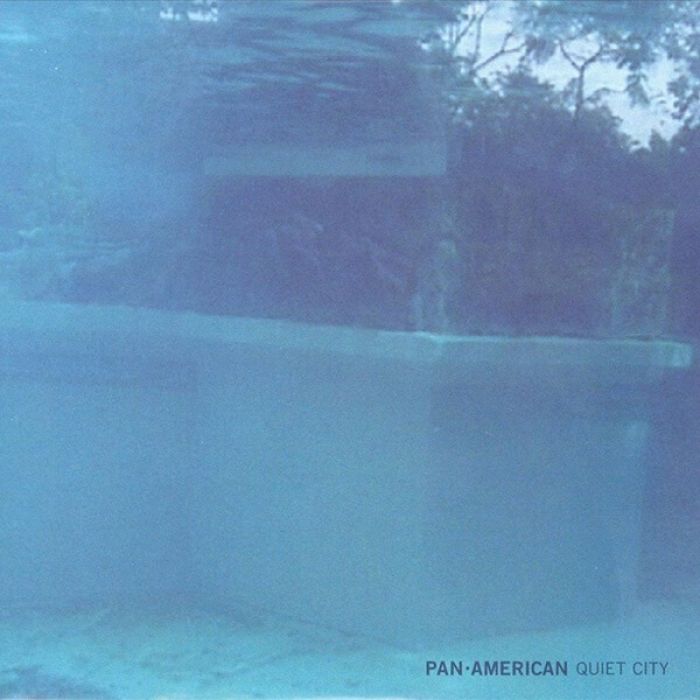Quiet City by Pan•American (Review)

Although you’d think that the sparse, atmospheric nature of Pan-American’s Quiet City would make it perfect sleepy time music, I would beg to differ. The first time I really listened to the disc (actually, “absorbed” might be a better word) was the morning I returned from Lawrence after seeing Múm. I’d only had a couple hours of sleep in the last 30 or so, and so I slipped this CD into the player, sprawled out on the living room floor, and hoped to get a little rest. I figured, based on Pan-American’s previous releases, that this would be the perfect music for unwinding. I was wrong.
What I got was fitful rest populated by some pretty bizarre and disturbing dreams, and I awoke in a much stranger mood than before.
By no means am I trying to warn people off from Pan-American’s latest, or claiming that Mark Nelson places subliminal messages in his music (although his whispered vocals could probably count as such). If anything, the fact that the music affected my sleep like it did is, for me, a testament to Nelson’s skill as a musical arranger, and proof that this is not the mere background music that most might assume it to be.
With both of his projects — post-rock trio Labradford (who needs to release a new album soon) and Pan-American — Nelson has proven time and again that musical subtlety can exude a power and grip all its own, that atmosphere and silence can be just as important and affecting as anything else. Sure, anyone who has listened to Low knows this already, but Nelson’s projects have taken that musical truism to new levels. And that’s doubly true with Quiet City, Pan-American’s finest, subtlest, and most atmospheric release to date.
If you want any proof of Nelson’s skill at composing and arranging sparse sound palettes, look no further than the album’s second track, “Wing.” It’s easy to break “Wing” down to its individual components: percussion rattling in the distance; crisp, glitch-laced drones; a dubby bassline; barely-there synth melodies; and soft washes of static. That’s really all there is to it. None of those would probably be terribly gripping on their own, and yet, Nelson takes these simple elements and combines them in such a way that it becomes a highly evocative piece — as if you’re watching the lights of some distant desert city slowly fill the horizon as night ensues, while the stars slowly appear, shimmering high overhead.
True, the track never really goes “anywhere” or does “anything,” and it’s ending is pretty much arbitrary (Nelson could’ve let it go on for 20 minutes or cut it off after two), and yet the feeling of vastness is almost overwhelming. The song doesn’t move forward so much as sideways, filling and spreading out, hinting at limitless horizons.
Quiet City is just that — quiet. Very quiet. Nelson has drastically stripped away much of his sound palette, revealing the naked emotional core that has always fuelled his music, be it Pan-American’s or Labradford’s. Gone are many of the electronic, dub, and techno elements that comprised much of Pan-American’s last two albums. And the greater prevalence of live instrumentation (including upright bass, live drums, trumpet, flugelhorn, and Nelson’s guitar) is almost a throwback to Pan-American’s self-titled debut. However, Quiet City even surpasses that album, stripping things down even further and going even more minimal, and it works wonderfully as a result.
On “Inside Elevation,” distant drones and Tim Mulvenna’s lightly brushed drums hover in the background, patiently observing as Nelson’s sparse, Morricone-esque guitar and David Max Crawford’s horns circle around each other in a solemn, funereal showdown. Another Morricone-esque guitar line serves as “Skylight“ ‘s center, floating about like a spectre from one of the ghost towns located in Labradford’s magnificent Mi Media Naranja. “Skylight” is one of the album’s finest tracks, the guitar’s elegiac tone accented perfectly by the horn arrangement and Nelson’s muffled, AM radio vocals. It’s one of the closest things to a real “song” that Pan-American has recorded since the debut, and another perfect summation of the sound Nelson’s accomplishing on this latest album.
But nothing compares to “Het Volk,” one of the finest things Nelson has ever laid to tape. Again, the construction is simple — soft, hazy tones flutter about like distant radio signals waltzing through the airwaves, joined by mournful flugelhorn and Steven Hess’ muffled percussion — but the resulting structure is haunting and emotionally complex.
The contemplative “Lights of Little Towns” closes things out on a nostalgic note. Reminiscent of a Do Make Say Think closer, an e-bowed guitar slowly meanders through plucked acoustics, a soft bassline, ringing cymbals, and gentle electronics. One would expect to hear such a track after an arduous journey, the reward for making it through a dense, challenging album. But on second thought, that’s just what Quiet City is, regardless of its minimal sonics.
Quiet City is the most emotional and affecting Pan-American album to date, and the fact that it sounds far simpler than it really is, that it comes off as mere background music and yet can still wind its way into your (sub)conscious, is proof yet again that Nelson’s subtlety is truly a force to be reckoned with.